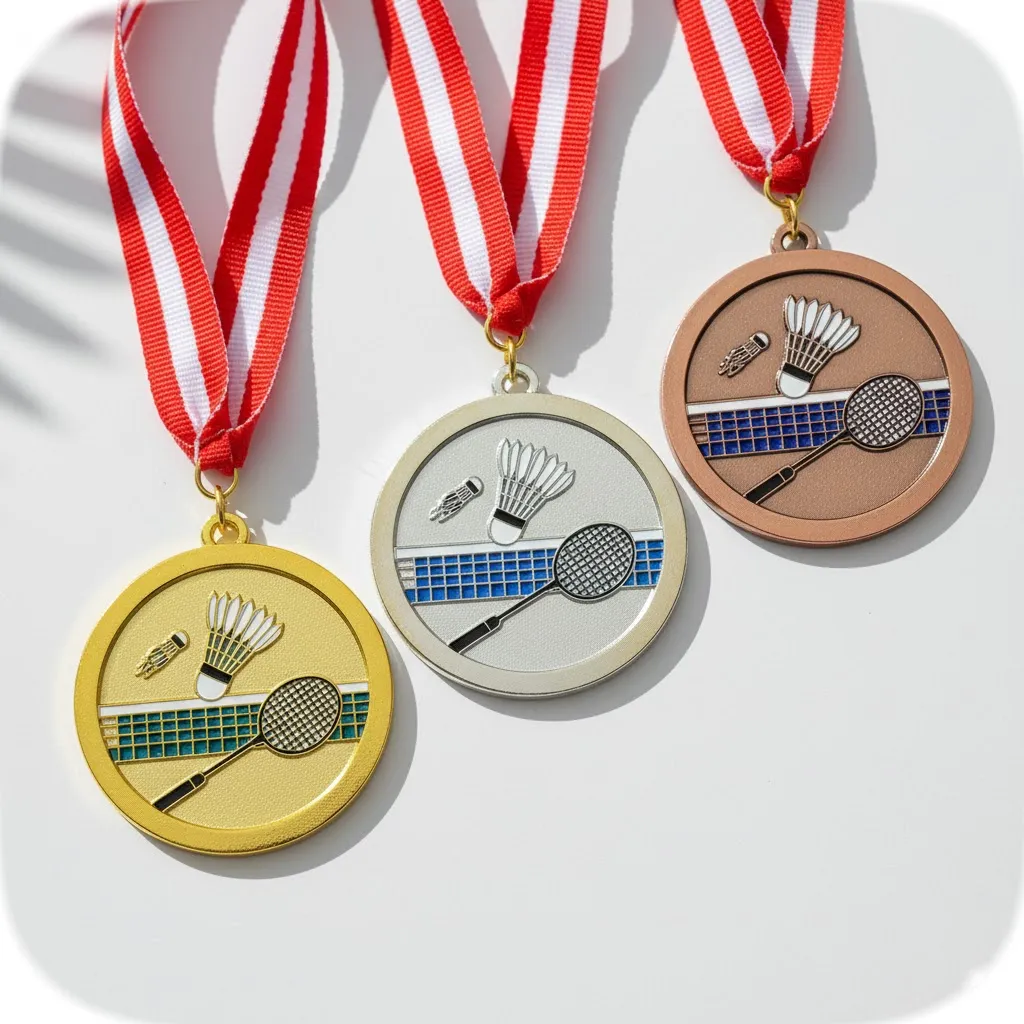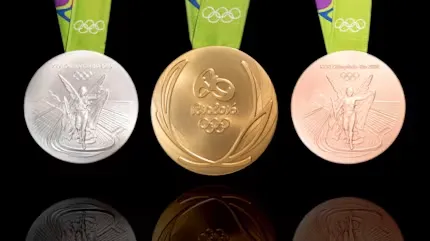
Top Trends in Custom Pin Design
Table of Contents Custom lapel pins and custom pins are more popular than ever! They are a fantastic, tangible way

Badminton awards, including premium badminton medals and classic badminton participation trophies, come in various forms to recognize achievements, inspire participation, and celebrate excellence in the sport.
Medals, being the most common awards in badminton tournaments, are especially awarded to the top three players or teams.
Gold medals, given to champions, represent the epitome of achievement and are frequently linked with high-profile competitions like the Olympic Games and BWF World Championships.
Runners-up receive silver medals, recognizing their brilliant performance, while third place winners take home bronze medals. These badminton medals are not only testaments to triumph but embody the fierce competition and commitment needed to perform at such elite levels.
For international events, the design, material, and engraving of these trophies typically represent the host country’s culture, enhancing the award even more.

Trophies take center stage in team competitions such as the Thomas and Uber Cup, where badminton trophies symbolize team accomplishment and national pride.
For these events with the national teams, beautifully crafted trophies are handed to the winning team. Take, for instance, the Thomas Cup trophy, which was originally awarded in 1949.
In addition to global competitions, team awards, including badminton medals, are prevalent in local leagues and scholastic tournaments, encouraging camaraderie and cooperative play.
Participation awards, such as badminton trophies and ribbons, play a crucial role in motivating amateur players. These may be handed out to all players in minor competitions or junior leagues, where the emphasis is on effort and participation rather than winning.
Such awards, including badminton medals, aid in confidence building and encourage players to keep pushing forward in improvement, forming an essential part of grassroots badminton development.
Custom awards for special achievements, such as badminton trophies for the most improved or best doubles team, add a personal touch by recognizing players for their specific contributions.
In certain tournaments, a points-based system is used, where prizes, including badminton medals, are awarded to players with the most points accrued during the season, highlighting additional ways in which excellence is recognized.
Badminton medals represent more than just themselves; they symbolize the highest triumph in the game, acting as a monument to the discipline, talent, and dedication needed to play at the elite level. For athletes, these medals represent more than just an achievement; they’re a symbol of the blood, sweat, and tears shed in pursuit of their victory. They embody victory, like when Indonesian wunderkinds Susi Susanti and Allan Budi Kusuma claimed their country’s first-ever Olympic golds, highlighting the ferocity fueling every win. Winning badminton trophies is often the ultimate goal for competitors at every level.
The cachet of an Olympic gold medal in badminton is still unchallenged. One of the most coveted trophies in sport, it represents both individual achievement and national honor. To nations like China and Indonesia, where badminton is part of the national fabric, these triumphs bring supporters together in a frenzy of jubilation. The fact that badminton was a demonstration sport at the 1972 Munich Olympics was an important milestone because it sent the game to the global stage and further increased the worth of these medals. Every triumph is a testament and builds upon the heritage of champions such as Rudy Hartono and Hwang Hye-Young, whose legacies define greatness in the world of badminton.
Medals mean a lot to the players and to the countries. They come to represent the epitome of perseverance and collaboration, like British duo Marcus Ellis and Chris Langridge, whose underdog triumph motivated many. Korean players Lee Kyung-won and Lee Hyo-jung’s medal victory symbolized the significance of collective efforts, embodying the profound connections among teammates, coaches, and families. These victories stir emotion beyond the court, creating a sense of identity and pride that crosses borders, especially during tournament seasons.
Medals hang as timeless testaments to an athlete’s triumph and legacy. They celebrate the competitive spirit and the bonds formed through sport. Athletes such as Zhang Nan and Zhao Yunlei exude humility and confidence, symbolizing victory in a larger sense. In the end, these medals represent more than just glory; they’re a complex symbol of personal accomplishment, cultural worth, and historical import, encapsulating the essence of badminton excellence.
Badminton medal design has undergone some incredible evolutions. Early badminton competitions awarded plain medals, typically silver or bronze in color, reminiscent of the early Olympics. Gold medals were reserved for the superlative, with designs that were utilitarian, featuring either simple engravings or laurel wreaths to denote victory and quality. Although simple, these early designs paved the way for the sophisticated artistry of today’s badminton medals, which have become symbols of excellence in the sport.
Incorporating national and cultural elements has become a hallmark of medal design, particularly in international competitions like the Olympics. For instance, the incorporation of local motifs, such as tribal patterns or national symbols, connects every medal with the host country’s identity. A prime example is the Rio 2016 Olympic medals, which showcased Brazil’s biodiversity and were crafted from recycled materials. This effort not only highlighted environmental awareness but also celebrated the host country’s unique heritage, establishing a new standard for sustainable badminton trophies manufacturing.

Technological innovations have transformed the craft of medal making, with cutting-edge materials like carbon fiber and steel now utilized alongside traditional metals. These contemporary materials offer greater durability and creative possibilities. Technologies like 3D printing have enabled complex ornamentation, pushing the boundaries of medal design. We’ve witnessed this evolution with badminton medals, which now feature layered textures and dynamic shapes that echo the sport’s energy and precision, making them perfect awards for medalists.
Medal design has become a way to demonstrate the host nation’s identity, especially during the Olympics. Tracing the evolution of medal design, from Greek-inspired motifs in early Games to Japan’s use of traditional patterns in Tokyo 2020, shows how this tradition transforms medals into ethnographic objects that provide a glimpse into local culture while honoring international sports achievements.
The awarding ceremony for badminton is a traditional and exciting part of the game, especially at elite events such as the BWF World Championships. This is where the competition wraps up and athletes’ accomplishments are honored with prestigious badminton trophies. Following the last game, the awarding ceremony usually occurs on the playing court or in a special area at the venue. The environment is festive and appreciative, highlighting the importance of their commitment and talent.
It starts with the announcement of winners, typically by dignitaries from the host country or BWF officials. Gold, silver, and bronze medalists step forward, their names resounding through the arena. The medals are awarded by dignitaries, sponsors, or special guests, emphasizing the honor of receiving badminton medals. The event involves not only player and coach attendance but also the presence of dignitaries, sponsors, and invitees, thereby underscoring its significance.
National anthems and flags at the ceremony cannot be emphasized enough. The gold medalist steps on the top podium, their country’s flag is raised, and their national anthem is played. It’s really symbolic because this is not only an achievement for the athlete but for their country. There’s nothing more special than seeing your flag shooting up and your anthem echoing throughout the venue, linking you and your country together as one. It is a tear-jerking moment for athletes and audiences everywhere, drawing all nations together in a spirit of harmony and admiration.
The podium is a stage on which the dedication and accomplishment of athletes are celebrated. Its tiered structure, with the gold medalist at the apex, represents their accomplishment. The ceremony on the podium in front of the world is a moment for many players that represents the high point of their careers. This acknowledgment of their work in the public arena provides a feeling of accomplishment and affirmation for years of preparation and dedication.
To receive a medal before a cheering crowd is in itself a highly emotional moment. The cheers and awe from onlookers magnify the triumph and etch it into a lifetime of remembrance, making the experience unforgettable for all involved.
Badminton medals represent more than success on the court; they are instrumental in crafting athletes’ careers and the sport itself. For players, medals, such as Olympic or World Championship victories, significantly affect their ranking, which can open doors to compete in elite-level tournaments, sponsorships, and recognition. A top ranking indicates sustained excellence and ability, and these badminton trophies tend to be career markers for sportsmen. For numerous athletes, it is more than a medal; it is the result of years of hard work, determination, and self-development.
Badminton awards motivate upcoming athletes by highlighting the pinnacles of achievement attainable through commitment. Observing athletes receiving badminton medals, usually through tears of elation and pride, can inspire young players across the globe. Their tales of triumph—battling through injury, dealing with defeat, and having the courage to continue—strike a chord with competitors in the making. As such, these moments impart lessons that extend beyond the court, including perseverance and collaboration, propelling us to approach not only badminton but our own dreams with invigorated dedication.
Medals are equally important to national badminton associations and teams. Countries that regularly produce medal-winning athletes, such as China, Indonesia, and Denmark, solidify their standing in the international community. These triumphs echo the power of their training infrastructures and motivate local engagement in the sport. For example, a gold medal at an international event can ignite increased participation at the grassroots level, generating a cascade that reinforces the sport’s infrastructure.
Trophies and medals market badminton worldwide by drawing attention and generating interest in the sport. These elite prizes, including premium badminton medals designed for various tournaments, put a spotlight on badminton’s competitive and emotional resonance, bringing it to light in areas where it has yet to shine. That visibility draws sponsors, broadcasters, and new fans, guaranteeing the sport’s ongoing expansion.
Custom badminton tournament awards are making their mark on both the local and world stage. These awards are custom fitted to the identity of the competition, with custom themes, colors, and event logos. From local amateur leagues to global championships, organizers are looking for ways to make their awards unique. Badminton trophies, medals, and other personalized options are designed in tune with the mood of the event, making participants and champions feel appreciated in a special manner. For instance, a neighborhood competition might have medals with vibrant, whimsical artwork, whereas elite competitions choose elegant, minimalist trophies.
Custom engraving is another great enhancement to custom badminton contest awards. These engravings can be the player’s name, event title, or even an inspirational message, transforming a medal or trophy into a cherished memento. This personalizes the heart of the award; it’s more than just a prize. For example, a gold medal etched with “Champion of the 2023 International Open” transforms into a treasured memento of the sweat and determination behind the victory. Engravings help separate awards for winners, runners-up, and participants so that all levels of competition feel fair and acknowledged.
Custom awards are a great fit for all ages and skill levels of badminton. Youth tournament medals might be fun and colorful, while the awards for adults are more elegant and classic. Entry-level events might feature simple but attractive trophies, while high-stakes championships deliver more elaborate awards to match. This versatility guarantees that each competitor appreciates it, irrespective of their division or expertise.
Custom Medal Manufacturers have to balance quality against cost. They offer everything from cost-effective resin-based medals to high-end presentations like metal or glass. Rates depend on size and complexity of design, and locally owned businesses often underwrite stuff like that. After all, these awards inspire players, enhance the event’s prestige, and act as enduring symbols of success.

Table of Contents Custom lapel pins and custom pins are more popular than ever! They are a fantastic, tangible way

Table of Contents Choosing between soft and hard enamel pins can make or break your custom pin project. While both
No. 5, Tongan Road,
East District Xiaolan Town,
Zhongshan, Guangdong,
China
Copyright © 2024, Zhongshan Peakeen Gifts Supply Chain Co., Ltd. All rights reserved. Powered by PeaKeen Privacy Policy
Let’s work together to achieve business growth!
Let’s work together to achieve business growth!
10% Off